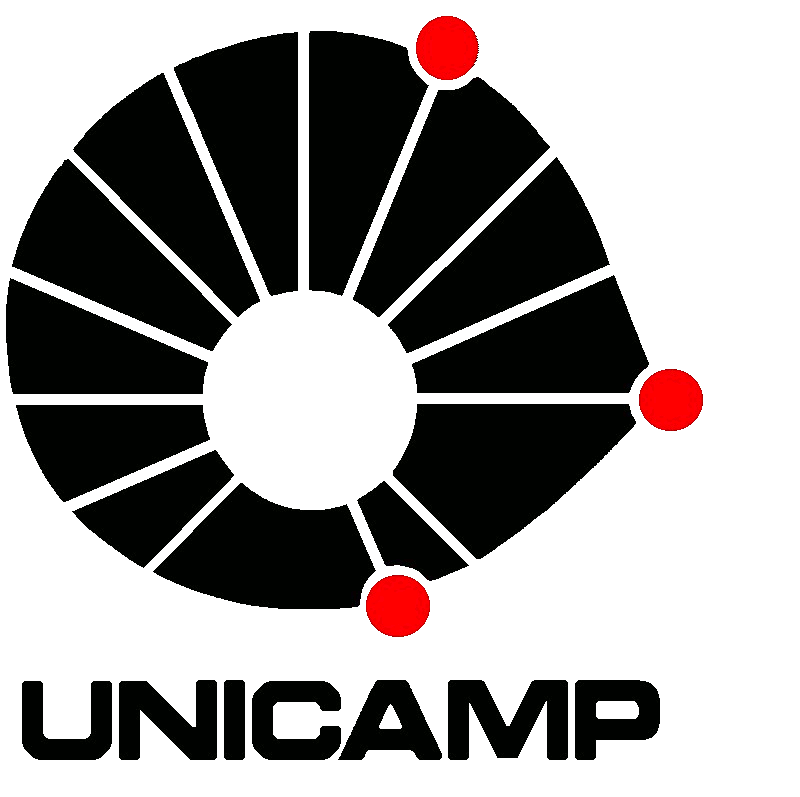You are here
b) Aula 2 - SOAR: Tutorial 1
Relatório 2 - SOAR - Tutorial 1.
Conteúdo:
- Atividade 1: Instalando o SOAR.
- Atividade 2: Construindo um Agente SOAR Simples usando Regras.
- Atividade 3: Agentes Simples utilizando Operadores.
- Atividade 4: Criando um Agente para o Water Jug Problem.
- Observações e Conclusões: Conclusões sobre as atividades e observações sobre o assunto.
Atividade 1: Instalando o SOAR.
-Download:
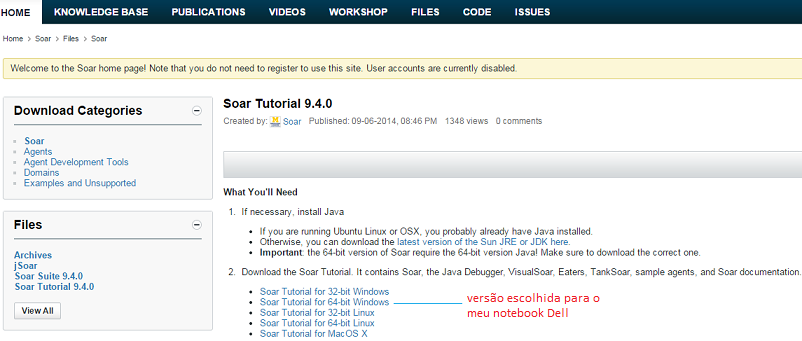
- Diretório do SOAR:

Atividade 2: Construindo um Agente SOAR Simples usando Regras.
Criando um Agente SOAR e Utilizando o SOAR Debugger:
# Executando o Hello World do SOAR
O objetivo desta atividade, como todo programa Hello World, é apresentar as funcionalidades básicas da plataforma/arquitetura. Portanto, será criado um agente simples para o entendimento. O roteiro recomenda utilizar o SOAR Debugger, já que este permite depurar a execução do programa e trackear passo a passo o seu funcionamento. Para executar o SOAR Debugger, execute o arquivo SoarJavaDebugger.sh, que se encontra na raiz da pasta onde foi instalado o SOAR. Tela inicial do SOAR Debugger:

Após carregado, o programa HelloWorld é executado:
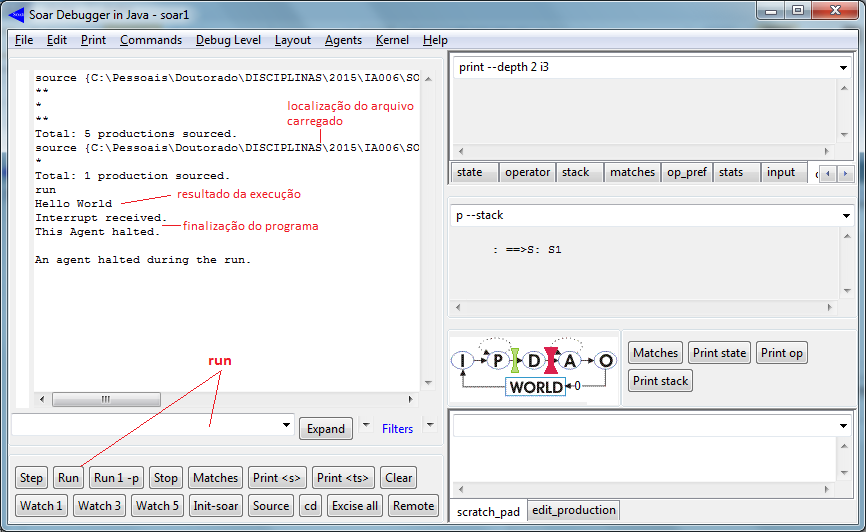
O código deste programa SOAR é bastante simples e pode ser visualizado no VisualSoar:
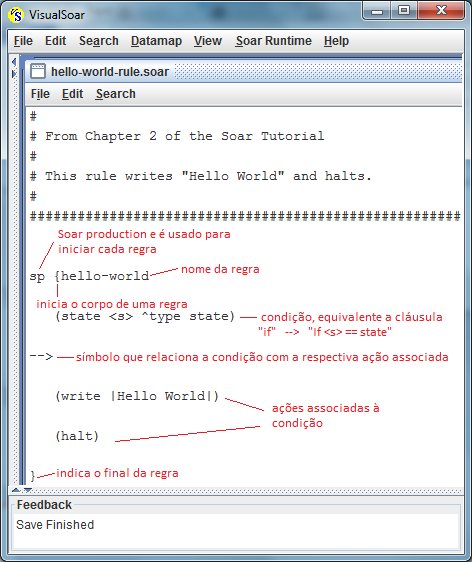
Toda regra SOAR segue o seguinte "template":

Utilizando a Memória de Trabalho
De forma simplificada, o processamento na arquitetura SOAR consiste da combinação apropriada e disparo de regras. As regras proporcionam uma representação do conhecimento flexível e, ao mesmo tempo, dependente do contexto, com suas ações dependendo da combinação de suas condições com as informações descritas na situação atual (contexto da working memory). Na arquitetura SOAR, existem regras que propõe operadores que criam novas estruturas de dados na memoria de trabalho, representando o operador e sua preferência, de forma que o operador possa ser considerado na seleção de ações. Existem também regras que avaliam os operadores e criam outros tipos de preferências capazes de de estabelecer indicações de preferencias entre os operadores disponíveis para a situação atual. Um trerceiro tipo de regra é aquela responsável pela aplicação da regra, mudando a memória de trabalho e refletindo as ações do operador sobre a situação atual.
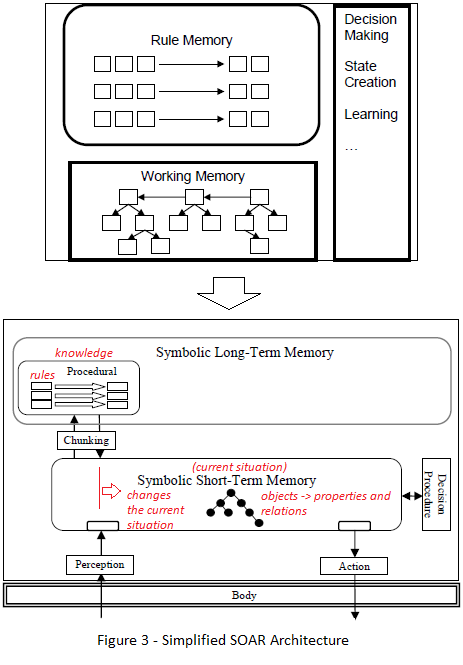
De forma a dar suporte à seleção e aplicação de operadores e proporcionar a interface para ambientes externos, Soar apresenta ciclo de processamento mostrado na Figura 4.
1. Entrada. Alterações à percepção são processados e enviados para a memória de curto prazo.
2. Elaboração. Regras avaliam vinculações de memória de curto prazo e a situação corrente. Por exemplo, uma regra pode testar se o objetivo é agarrar um objeto, a distância do objeto, e alcance do agente. Em seguida, cria uma estrutura de dado descrendo se o objeto está ao alcance e detalhes relevantes.
3. Proposta de Operador. Regras propõe operadores apropriados à situação atual, com base nas características da situação testada e nas condições das regras.
4. Avaliação do Operador. Regras criam preferências para os operadores propostos, com base na situação atual e no objetivo. As preferências podem ser simbólicas (A é melhor do que B), ou numéricas (a utilidade estimada de A é 0,73).
5. Seleção de Operador. O procedimento de decisão combina e avalia as preferências geradas e seleciona o operador. Se as preferências são insuficientes para tomar uma decisão, um impasse surge e o SOAR cria automaticamente um subestado cujo objetivo é resolver este impasse. No subestado, SOAR utiliza o mesmo ciclo de processamento, selecionando e aplicando operadores, de forma recursiva levando à solução automática e reativa, como um “meta-raciocínio”. Os impasses e subestados resultantes fornecem um mecanismo para executar deliberadamente qualquer uma das funções (elaboração, proposta, avaliação e aplicação) que são executadas automaticamente/reativamente através das regras.
6. Aplicação do Operador. As ações do operador são realizadas por regras que correspondem a situação atual e a estrutura operador. Várias regras pode disparar em paralelo e em seqüência, fornecendo um meio flexível e expressivos para ações do operadores. Se houver conhecimento insuficiente para a aplicação do operador, um impasse surge e leva à criação de um substado. Isto leva à decomposição dinâmica tarefas, onde um operador complexo é executado de forma recursiva por operadores mais simples.
7. Saída. Todos os comandos de saída são repassados para o sistema motor (engine).

A memória de trabalho contém todas as informações dinâmicas de um agente Soar, sobre o seu mundo e seu raciocínio interno. Ela contém sensores, cálculos intermediários, operadores e objetivos. Em Soar, toda a memória de trabalho está organizado como grafos de estados. Assim, cada elemento da memória de trabalho está conectado, direta ou indiretamente, a um símbolo de estado. Abaixo está um exemplo simples do que a estrutura da memória de trabalho pode ser, no caso em que o agente representa a existência de dois blocos, um em cima do outro, sobre uma mesa, como mostrado na figura abaixo:
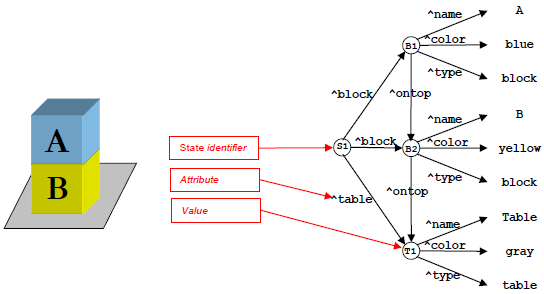
A figura do grafo abaixo ilustra uma estrutura básica de memória de trabalho criada automaticamente pelo SOAR para todos os agentes. Portanto, apesar de não ser normalmente mostrado, o estado inicial S1 apresenta a seguinte estrutura:
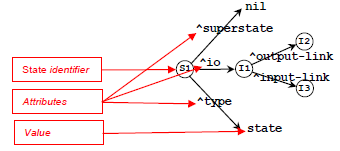
Como um gráfico, há nós (ou vértices) e links (ou arestas). Os nós, tais como S1, B1, B2, A, e “blue”, estão conectados por links, como block, table, name, color e supertate. Soar tem dois tipos de nós: identificadores e constantes. Os nós que podem ter ligações que deles emana, nós não terminais, como S1 e B1, são chamados identificadores, enquanto os outros, nós terminais, como state, blue, block, e nil, são chamados constantes.
No exemplo acima, S1 é o identificador para o estado. Todos os símbolos identificadores são criados automaticamente por Soar e constituído por uma única letra seguida por um número. Embora I2 e I3 na figura mais a baixo não tem quaisquer ligações que emanam deles, eles são identificadores e podem ter
subestruturas adicionadas. Em contraste, o símbolo state não é um identificador e não pode ter links que emanam a partir dele. Os links são chamados atributos em Soar e são precedidos por um "^". Somente identificadores têm atributos. Na figura de fundo, S1 tem três atributos: superstate, io, e type. I1 tem dois: output-link e input-link
Atividade 3: Agentes Simples utilizando Operadores.
O programa "Hello-World" desenvolvido anteriormente apresentava apenas uma regra, de aplicação direta, sem operadores. Isto faz algum sentido já que trata-se de uma única regra no contexto e de aplicação realmente direta.
Obviamente, o mais comum é termos contextos mais complexos, onde regras terão suas condições avaliadas e comparadas aos estados existentes na memória de trabalho, e os operadores recomendados por estas regras aplicados ao contexto, modificando a situação corrente. Para usar um operador, é necessário duas regras: uma para propor o operador e outra para aplicá-lo quando ele é selecionado.
A tela do VisualSOAR mostra o programa "Hello-World" modificado para conter regras que recomendam um operador em caso de uma situação específica.



O Tutorial faz algumas recomendações de configuração do SOARdebugger antes da execução:
- Usar o comando excise –all, ou o botão correspondente, para destruir agentes executados anteriormente e limpar todas as regras existentes na memória.
- Alterar o nível watch para watch 5, fazendo com que o Soar Debugger apresente mais detalhes da execução.
A execução no SOAR Debugger:

Utilizando o Visual SOAR:
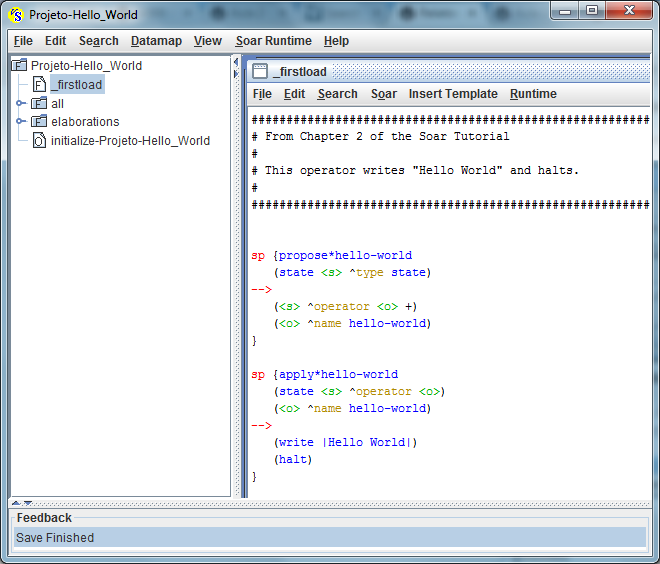
Um dos recursos mais importantes do Visual SOAR é o Datamap. Esta ferramenta permite visualizar a estrutura de dados corrente na memória de trabalho:
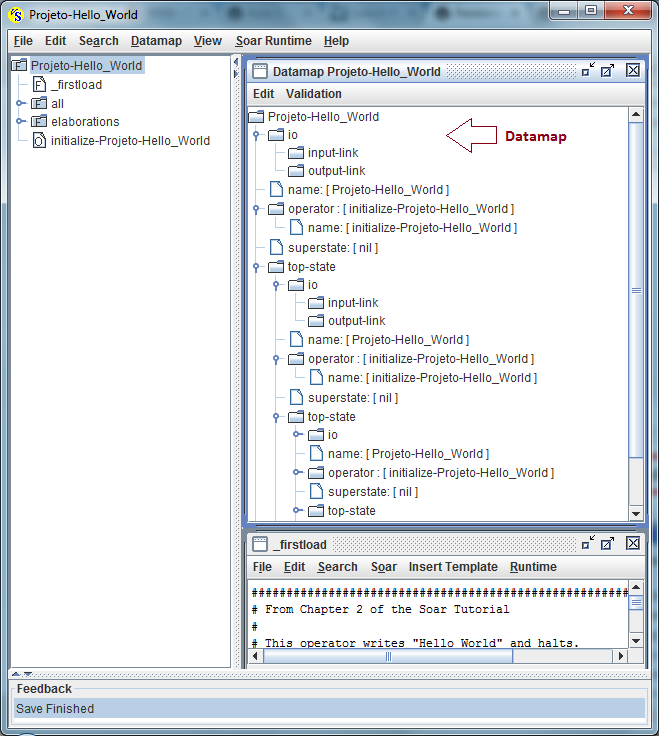
Áreas funcionais do IDE Visual SOAR:

Atividade 4: Criando um Agente para o Water Jug Problem.
Descrição do problema:
Goal: to fill the three-gallon jug with one gallon of water.
Space of possible states: determined by the objects that are available to be manipulated (the two jugs) and their possible values (0-5 gallons full). A problem is then defined as an initial state that the problem solver starts at, (in this case two empty jugs) and a set of desired states (any state where the three-gallon jug has one gallon of water). To represent the states in the water jug problem, we will have two values: the amount of water in the five gallon jug, and the amount of water in the three gallon jug. For example: 5:0,3:0 will represent that the 5 gallon container has 0 gallons of water, and the 3 gallon container has 0 gallons of water. Below is a trace of the optimal solution for the problem showing the states and the operators that are applied to each state.
Problem solving: consists of starting at the initial state, then searching for a desired state by applying operators, which transform one state into another. For the water jug problem, the operators are fill a jug, empty a jug, and pour from one jug to the other.
knowledge: "never emptying a jug immediately after it has been filled".
Desenvolvimento:

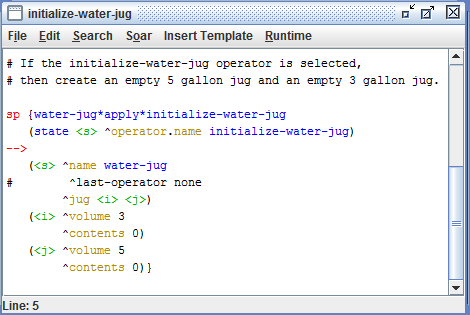
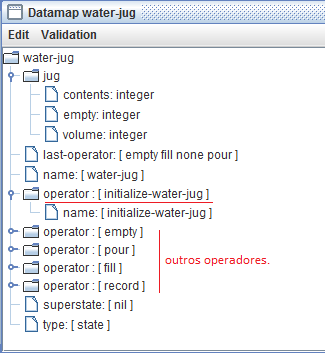

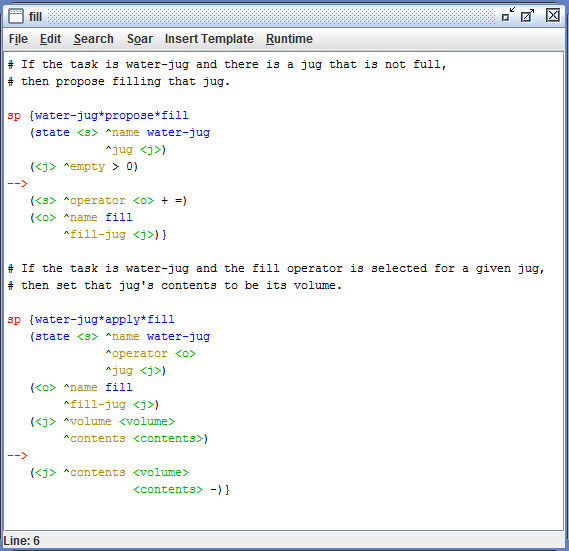
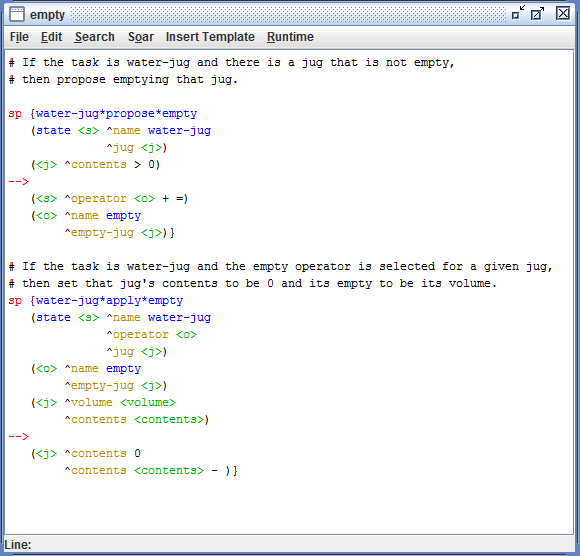


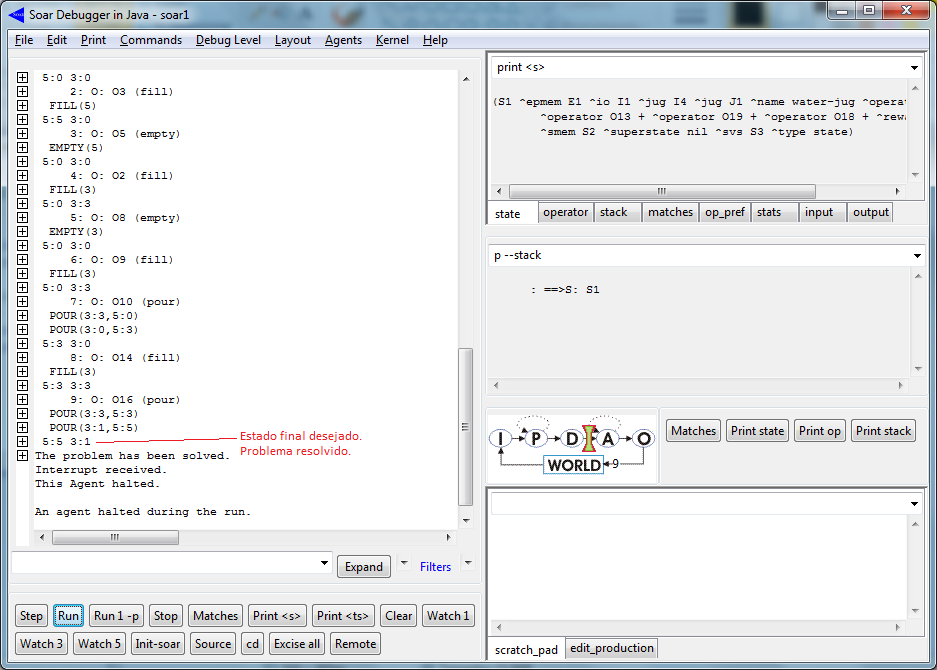
Observações e Conclusões:
Nesta aula foi possível entender melhor, na prática, os mecanismos da plataforma SOAR.
Foi possível perceber que a linguagem é bastante intuitiva, porém, caso a plataforma ganhe importância, ou seja empregada para a solução de problemas mais complexos, será necessário o desenvolvimento de uma linguagem de modelagem capaz de traduzir informações e mecanismos de “negócio” para a linguagem computacional.
Não parece ser uma tarefa impossível já que neste exercício vimos a semelhança entre as versões em inglês e em SOAR. Talvez um mapeamento UML -> SOAR seja possível.
De todos os artefatos e facilidades do SOAR que examinei neste exercício, o que mais me impressiona e chamou a atenção foi o papel das “Elaborations” descrito neste parágrafo:
“This rule will test the state and create a new structure on the state. This type of rule is called a state elaboration rule. State elaboration rules are ubiquitous in large Soar systems because they can create useful abstractions of combinations of other working memory elements and represent them directly on the state as a new augmentation. These new augmentations can then be tested in other rules in place of complex combinations of conditions, simplifying rules and making the structures in working memory more meaningful. A critical aspect of state elaboration rules is that they create i-supported working memory elements so that when the parts of the state they test change, they recompute their actions automatically.”
Tenho a impressão de que as “elaborations” tornam a plataforma SOAR mais interessantes e talvez seja por este artefato a viabilidade de integração com outros sistemas, permitindo melhorar o aspecto cognitivo e de inteligência.
Theme by Danetsoft and Danang Probo Sayekti inspired by Maksimer
